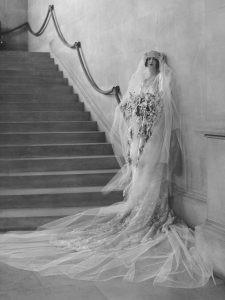George Vanderbilt, heir to a vast railroad fortune, officially opened Biltmore House in 1895, a magnificent symbol of wealth and artistry nestled in the North Carolina mountains. Despite possessing such grandeur, this opulent home initially lacked the warmth of family. As one of America’s most sought-after bachelors, George Vanderbilt had yet to find a partner to share his life and his extraordinary estate with. This all changed with the arrival of Edith Stuyvesant Dresser, marking the beginning of The Vanderbilt Family’s enduring legacy at Biltmore.
 Edith Stuyvesant Dresser engagement portrait
Edith Stuyvesant Dresser engagement portrait
In a courtship that blossomed into a profound romance, George Vanderbilt proposed to Edith Stuyvesant Dresser on April 28, 1898. Edith, a friend of the family and a woman ten years George’s junior, was celebrated for her refined beauty and captivating personality. Described as both worldly and cultured, yet remarkably humble and grounded, Edith proved to be George’s intellectual equal and kindred spirit. Their shared love for knowledge and exploration became a cornerstone of their marriage, enriching their lives with travel and continuous learning.
Their union began with an intimate civil ceremony on June 1, 1898, held in a town hall in Paris, France, a testament to their desire for privacy amidst considerable public interest. Honoring French customs, a religious ceremony followed the next day at the American Church of the Holy Trinity in Paris. Despite the widespread media attention surrounding the Vanderbilt name, the ceremonies were notably understated, attended by only their closest circle of friends and family. The newlyweds embarked on a tranquil honeymoon in Italy before making their way to Biltmore Estate, ready to begin their life together. Biltmore’s employees offered a heartwarming welcome to Edith as she arrived at her new home, lining the Approach Road to greet her. A striking horseshoe crafted from goldenrod flowers, bearing the words “Welcome Home,” served as a grand gesture, symbolizing the estate’s embrace of its new mistress.
Nurturing the Vanderbilt Lineage at Biltmore
Biltmore House truly became a family home with the birth of George and Edith’s daughter, Cornelia Stuyvesant Vanderbilt, on August 22, 1900. This joyous occasion resonated throughout the Vanderbilt family and was celebrated in local news. The Spartanburg Journal eloquently announced, “A new star has appeared at famous Biltmore, and the charming mistress of this most gorgeous home is smiling upon her first born, a tiny girl called Cornelia Stuyvesant Vanderbilt, and the world shares in her new found happiness.” Cornelia’s childhood was idyllic, spent within the expansive grounds of Biltmore, often playing with children from the families who lived and worked on the estate, fostering a strong sense of community.
Tragedy struck the Vanderbilt family when George Vanderbilt passed away unexpectedly in March 1914, following an emergency appendectomy. Cornelia was only thirteen years old. Edith Vanderbilt, demonstrating resilience and strength, returned to Biltmore after her husband’s death and undertook the formidable task of managing the family businesses and estate. Her stewardship ensured the Vanderbilt legacy would continue.
Generations of Vanderbilts: Continuing the Heritage
 Cornelia Vanderbilt wedding portrait in 1924
Cornelia Vanderbilt wedding portrait in 1924
Years later, Biltmore Estate once again became the setting for celebration as Cornelia Vanderbilt married the Honorable John Francis Amherst Cecil on April 29, 1924, at All Souls Church in Biltmore Village. The wedding was a significant social event, drawing guests from around the globe to the charming town of Asheville. John Cecil, a British diplomat and descendant of Lord Burghley, High Treasurer to Queen Elizabeth I, brought a distinguished lineage to the Vanderbilt family tree.
The Vanderbilt family story continued to unfold with the arrival of a new generation at Biltmore House. George Henry Vanderbilt Cecil was born in 1925, followed by William Amherst Vanderbilt Cecil in 1928, both within the walls of the iconic estate. While George and William received their education abroad in Switzerland and England, their roots remained firmly planted at Biltmore, where they spent holidays and summers. As adults, the Cecil brothers played crucial roles in the preservation and management of Biltmore Estate. William in particular dedicated himself to overseeing Biltmore House, its grounds, and The Biltmore Company, ensuring the estate’s future.
Today, Biltmore remains a thriving family enterprise. The fourth and fifth generations of George Vanderbilt’s descendants are actively involved in the daily operations, working alongside over 2,000 employees. Together, they uphold Biltmore’s enduring mission: to preserve this national treasure for generations to come, a testament to the Vanderbilt family’s lasting impact on American history and culture.
View Biltmore Estate Timeline

